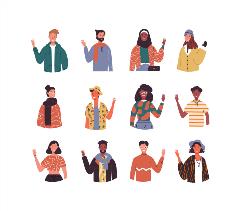A picture may be worth a thousand words, but a caption can paint a picture with words — just, please, don’t use a thousand.
When it comes to social media, the video or imagery used usually receives all the glory. And the artwork does deserve a lot of those roses thrown at their feet. As users scroll through their endless social media feeds, engaging, dynamic imagery is what will get people to stop and look. But the captions are what make people listen.
Social media is a direct line of communication to your audience — after all, users chose to follow your brand account.
The assets your brand produces to share with your followers are opportunities to start conversations, spark inspiration, invite them into your world and create loyal fans for the future.
And a lot of those engagements happen through the words used to communicate through in any given post.
So, why are so many captions we come across…not great? And what is it about them that makes them so lackluster?
A few of my thoughts as a copywriter…
ROBOTIC

Ever notice how some captions seem to be produced by an automatic copy generator? It’s all nouns and adverbs, but no heart and soul. Brands should treat caption copy like it’s a conversation between two people, not a brand shouting within earshot of anyone who will listen.
Avoid being too sales-y. At the end of the day, brand social media — especially product posts or social PPC advertising posts — are meant to make conversions. But, find a smoother, more subtle way to make your sales pitch that makes you sound like a trusted source of valuable information and less like a salesperson sweating over their commission.
LENGTH

Contrary to what you’ve heard, size matters. We’ve all been there: You see a social post, read the first line of the caption that’s visible and then hit the expand button to reveal what amounts to Tolstoy’s War and Peace. So. Many. Words.
Is long copy in a social post always bad? No. It has its place — especially in text that contain things like contest rules or public statements on societal issues as we’ve seen with the Black Lives Matter movement.
According to Sprout Social, there are sweet spots for how many words social copy should be ¾ for captions, PPC advertisements, headlines and more. And you might be surprised how short some of them are.
When in doubt, think small. If you throw too many words at your audience, they’re likely to lose interest and move on to the next thing before you’ve had a chance to make your point.
STYLE

When looking at some brands, you have to wonder, “Who is writing this?” Or, more appropriately, “How many people are writing this?” Too often, each post can feel disparate from the others with no anchor.
Brand tone of voice is vital to making connections with your audience. In fact, research conducted by marketing expert Felicia Sullivan shows 71% of consumers are more likely to recommend brands with which they have an emotional connection.
And that tone of voice will vary from brand to brand, and also from writer to writer. But by using brand guidelines and working closely with the brand team, you can collectively decide on what tone works best to communicate with your audience and get the desired outcomes.
So, what are some ways you can amp up your social copy game?
BE HUMAN

I mentioned earlier, you should avoid sounding robotic or cold in your copy. Use words as an opportunity to ask questions and learn more about your audience. What do they like? Let’s say your brand offers 12 different flavors of bubble gum — which is their favorite to chew? Learning little clues like these from your audience not only lets you in on what they want to hear more about, but also lets you see how they themselves talk to you and to each other.
When in doubt, be funny. Everyone likes a good laugh, whether they are following a bubble gum brand or a farm machinery brand. Even if your brand is more buttoned-up, find ways to make people smile — while remembering to be kind and thoughtful to who that joke might be about. Humor is a tool, not a weapon.
BE RELEVANT

One of the best ways to know what’s happening on the internet is to be on the internet. If you are working in social media, you should be active on all social media channels to follow trends both in culture and in language. This will help inform your copy and strategy for future content.
Also, keep some websites relevant to the industry in your bookmarks section to reference to make sure you know what’s in the zeitgeist. A few I check almost daily to keep myself in the know: Social Media Today, Stay Hipp, Know Your Meme and BuzzFeed.
BE STRATEGIC

If your brand or agency has a research and analytics team like LEAP Amp does, USE THEM. These folks are the detectives of trends, behavior and other audience markers that provide invaluable assistance in crafting copy and social content overall.
Taking the bubble gum brand example again. Let’s say your team loves the root beer flavor, so that’s the majority of your content each month. But your research and analytics team say that the audience doesn’t really respond well to root beer, but they do love the passion fruit and mango flavors. This is what you should be writing about — not root beer just because it’s your favorite.
Ultimately, the social content isn’t about your brand. It’s about your brand’s target audience. Use research to inform good strategy that will make your writing and communication stronger.
BE YOURSELF

Meaning: Be your brand, authentically. We all know the brands making a name for themselves being snarky or using only emojis as captions — and good for them! They should keep doing so, but that doesn’t’ mean you shouldn’t do so just because it’s working for them.
But you can learn from what they’re creating. There’s that old saying that there are no new ideas ¾ that there’s nothing new left to write. To some degree, that’s true. But, if you are inspired by another brand’s copy prowess, figure out why you like it, what it’s doing, and then break it down and reshape it to be something of your very own.
As Pablo Picasso (not a writer, but stay with me here) once said, “Good artists copy. Great artists steal.”
Think you know how to move forward on writing great copy? Or, think you need help from professionals? We’d love to hear from you. Say hello and let us know how LEAP Amp can help you craft the perfect lines.